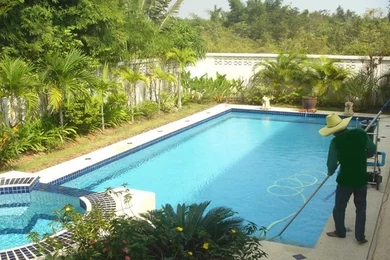In the past, swimming pools were only constructed in properties with ample outdoor spaces.
Having a huge lawn means you can have a larger pool, which provides users with more space for playing, exercising, and swimming. It also has both a deep and shallow end, which translates to more areas suitable for both adults and kids.
Bigger pools also mean there’s more room for accessories, such as inflatable rafts, float pool lounges, and volleyball game sets.
However, having a large yard isn’t a must if you want to have a swimming pool. Even if your outdoor space isn’t big, you can still have this water feature, which can give you, your family, and guests hours of fun, recreation, entertainment, and exercise.
Top Dubai pool contractors say that small swimming pools are great options since they don’t require a huge space, meaning you can have one even if you don’t have a large lawn.
If you have an existing garden or landscape, you won’t have to destroy or move the plants, walkways, decks, and other features to make space for the pool.
A pool safety inspections is a crucial component of pool ownership.
Small swimming pools also take less time and money in terms of care and upkeep. They are more cost-efficient since they don’t require a lot of energy to heat.
Moreover, due to its size, the outlay for a small swimming pool won’t be massive, and thus, it is more budget-friendly.
Having the Small Swimming Pool of Your Dreams
Since you have limited space, building a small swimming pool can be trickier and more challenging.
If you are looking for tips and ideas for building the pool of your dreams on a small lawn, read below:
- Follow the available space.
To make the most of your outdoor space, select a pool shape that follows the contours of the area where you want your water feature to go.
For instance, if you have a long and narrow side or backyard, opt for a simple rectangle swimming pool. This is one of the easiest strategies you can consider.
If you have an irregularly shaped lawn, consider designing the far side of the swimming pool to follow your property line as close as possible within the setback requirement.
- Design the deck wisely.
For the deck, use the available space near your house. Think about the biggest area possible that can accommodate the furniture you want to have.
Also, consider going with half a deck to save space, particularly if you are having a pool built near a property line, retaining walls, trees, and other landscaping features.
This means installing wood, concrete, stone, brick, or pavers on only one of the pool’s lengthier sides and on one or both of its short ends.
Usually, the best option is to install decking between the house and the pool and, if necessary, whichever end of the water feature provides the best access for entry and exit.
- Choose an above-ground plunge pool.
A plunge pool is a small, compact swimming pool. Because of its size, it is the recommended option in places with limited space.
Plunge pools are usually between 13 and 23 feet long and 7 to 10 feet wide, making them the ideal water haven for wading into and cooling off in the heat. They are also perfect for low-impact water exercises and hydrotherapy.
In a small yard, a plunge pool fits seamlessly into a raised deck. It is a great functional and appealing water feature that still comes with plenty of space for lounge and swing chairs, day beds, and even a lawn.
- Opt for a spool.
When space is extremely limited, consider having a hybrid of a spa and pool (a “spool”) constructed in your yard.
Technically, a spool is a large spa. Here, you can cool down and unwind and relax while submerged in the bubbling water.
Although smaller than traditional swimming pools, spools can accommodate more users at one time. They also have room for one or two features, such as a small tanning ledge.
- Go for a shallow pool.
Depth is one of the most important features you have to consider when designing a small pool.
If you are having a pool built for the first time, its depth determines the slant or grade of its floor. Each entry step must be more than a foot for safety and comfort.
If you want your pool to have the standard three steps, its maximum depth should be three or four feet at the pool’s bottom surface.
A small pool with a deep end greater than five feet will create an unsafe and awkwardly steep floor. To accommodate a more gradual slope, the pool’s overall length should be long.
To avoid this issue and make use of the available space you have, go for a shallow pool.
Keeping the pool to a maximum of four or five feet means you won’t need to worry about having a longer length, which is crucial for the slope.
- Design dual-purpose steps.
Most modern inground pools contain a tanning ledge, a raised area submerged in extremely shallow water.
It is an additional area in the pool where children can splash and play around safely and where you can sit in the water without the need to swim or float.
If you want a tanning ledge but are afraid it won’t have a place in your small pool, you can turn the first entry step into this feature.
Simply expand the dimensions of the first step and you’ll have the perfect tanning ledge idea for your and your kids’ various refreshing activities.
Although a hybrid step-tanning ledge will take up some pool space, when compared to building a separate tanning ledge, this trick will help you save several square feet.
- Make use of walls.
A great technique for conserving valuable space in a small yard involves incorporating walls.
The trick is to put the pool into a corner or edge of your yard and have one or two walls put up on one of the sides so that they perform additional functions.
If you choose a high wall, it can function as a retaining wall to hold back soil and water from flowing. It will also create a boundary for your property and provide privacy for you and your family.
You can also use this wall to incorporate other water features that can complement your pool.
Examples of these are curved deck jets and scuppers that release sleek streams of water and other cascade-style water features.
An experienced pool contractor can employ many of these tips and strategies to give you a functional, appealing pool that is ideal for your small outdoor space.
With their help, you can stay cool in the summer and all year round right in your own home.
AUTHOR BIO
Rachel Hennessey manages the Pools and Landscaping Division of Hennessey LLC. She also works on Tender and Pre-Qualification and brings in new business to the company’s Construction, Interiors and Civils Division.


















